Located in the capital, Stockholm, Sweden’s National Museum of Science and Technology—the Tekniska Museet—turns 100 this year. “Back in 1924, the country was among the poorest in Europe and needed to train more engineers to get industry going,” says Astrid Stenberg, project leader for visitor experience at the museum, which is run under government charter by a private foundation. “Today the Wisdome program comes at a time of huge challenges ahead,” she continues, referring to a decade-long joint initiative by five Swedish science museums to build state-of-the-art dome theaters. Showing immersive 3D visuals—everything from the latest satellite imagery of the solar system to specially made films explaining processes such as photosynthesis—these 360-degree cinemas are intended to wow a new generation of young Swedes and encourage them to study science when they’re older.
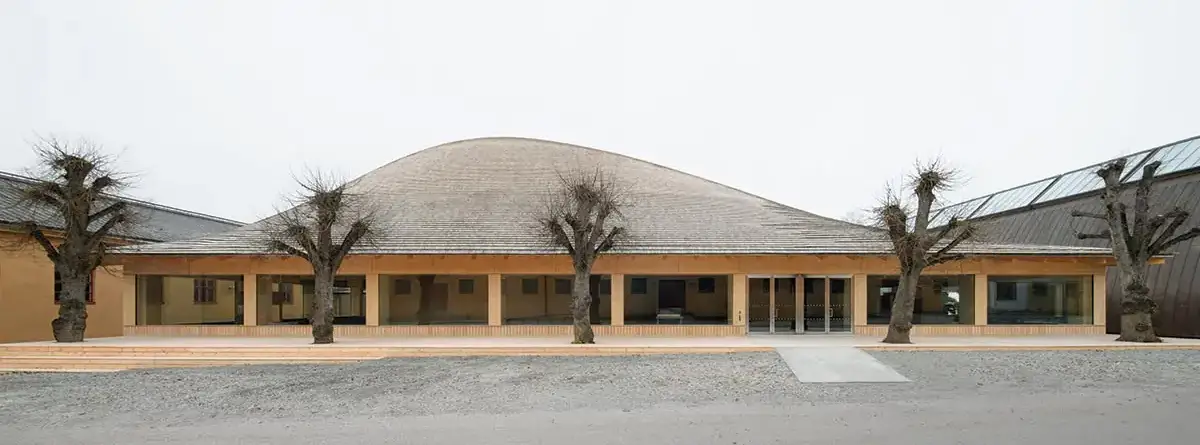
1
Positioned next to military structures, the low-slung building (1) bulges to accommodate the dome theater (2). Photos © Mikael Olsson, click to enlarge.
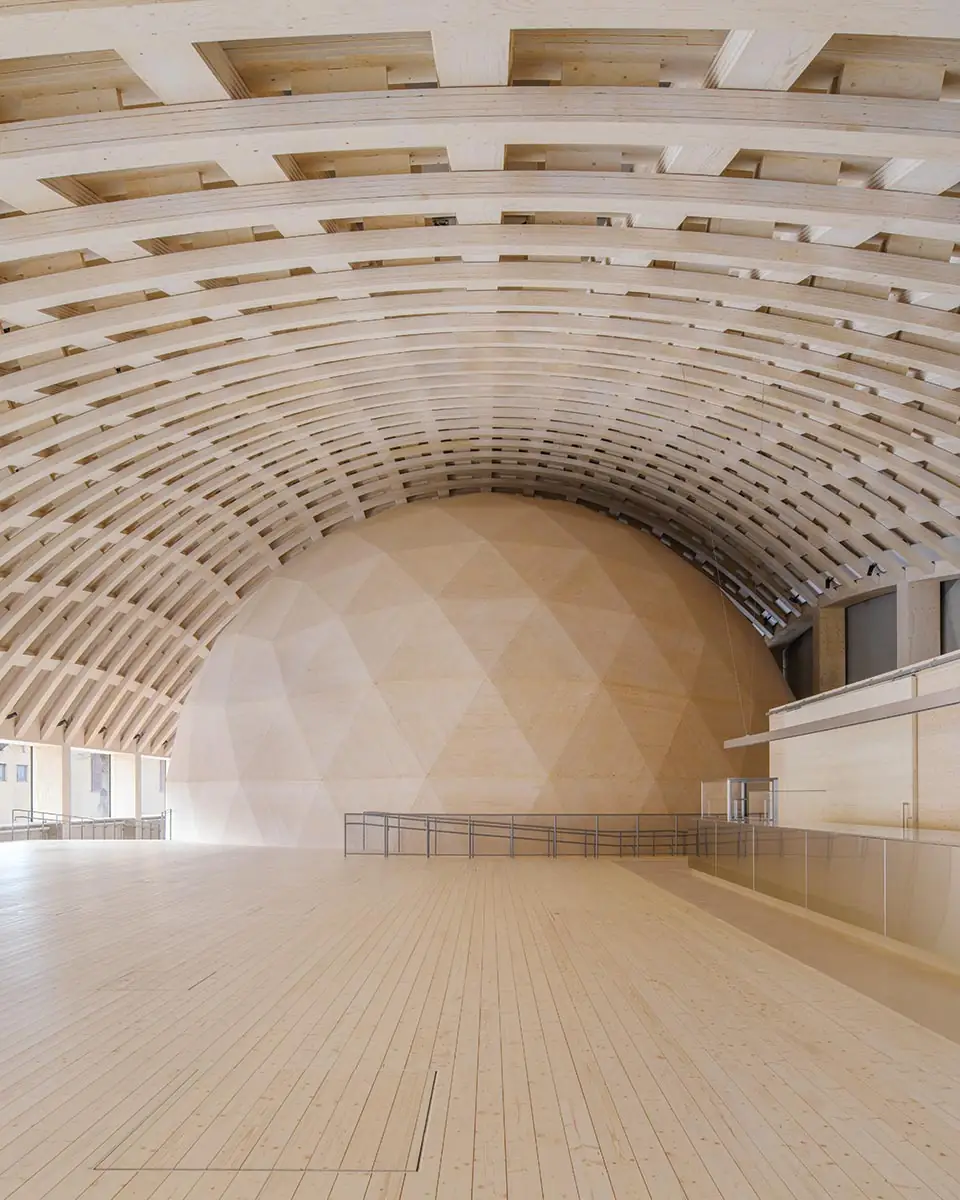
2
Last of the five, the Tekniska Museet’s Wisdome, which opened in December, is also the most architecturally ambitious, since the museum used the opportunity to incorporate a new events hall. Among the sponsors was the Swedish/Finnish wood-and-paper giant Stora Enso, which agreed to supply cross-laminated timber (CLT) and laminated-veneer lumber (LVL) for the project. “We thought, ‘Let’s build in wood, let’s challenge the Swedish construction industry,’” explains Stenberg. Entrants to the 2019 design competition therefore had to make convincing use of these engineered-timber products, a challenge the winning office, Stockholm’s Elding Oscarson, rose to with bravura by looking to historical precedents, in particular Frei Otto and Carlfried Mutschler’s 1974 Multihalle in Mannheim, Germany, which is still the world’s largest self-supporting timber grid-shell structure.
Initially located downtown, the Tekniska Museet moved to its current site, in the Royal National City Park, in the wake of the Stockholm Exhibition held there in 1930. Partially inspired by Stuttgart’s Weissenhofsiedlung, the fair marked the triumph of the International Style in Sweden, and it was in rather dourly Functionalist mode that the architect Ragnar Hjorth completed the new museum in 1936. Two years later, the initial building, which closes the fourth side of a courtyard formed by three 19th-century military structures, was extended with the addition of a barrel-vaulted concrete hall at its rear. Another extension was added in the 1990s, that time in the form of a mostly windowless rectangular structure that filled up one half of the remainder of the courtyard. A similar building was intended for the other half, but never constructed, and it is there that the Wisdome makes its mark today.
“In addition to the dome theater, the brief called for a one-story hall that could house large-scale gatherings,” recalls Jonas Elding, founding partner, alongside Johan Oscarson, of Elding Oscarson. “Rather than having the theater sticking up next to the hall, we really liked the idea of having the globe inside as the centerpiece of the space.” After ruling out a giant box, they began exploring hybrid possibilities, in consultation with their structural engineer, Oslo-based Florian Kosche, who they brought onboard at the outset to ensure that form and structure would develop in tandem. The irregular diagrid dome of the Multihalle, built for Mannheim’s garden festival, was an obvious reference in the circumstances. With this precedent in mind, the architects devised a glass-walled rectangular-plan structure (82 by 157 feet) that enclosed the dome theater at its far end, next to the ’90s extension. On this orthogonal base, without a single intermediate support, they imagined an enormous and asymmetrical LVL-lattice vault rising up to enfold the theater within the volume of the hall.
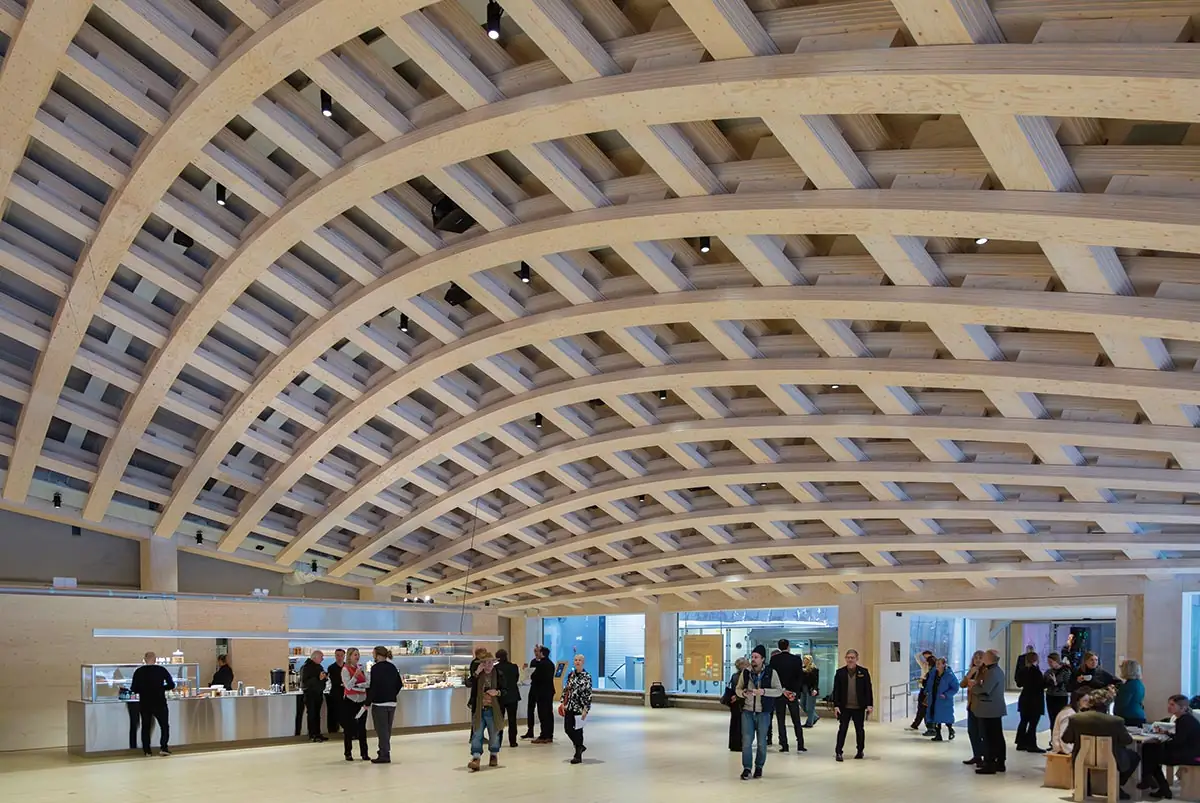
The hall accommodates large-scale gatherings beneath its LVL-lattice vault. Photos © Anna Gerdén
“It sounds easy, but it was a long process,” says Oscarson. One of the first challenges was finding a contractor that could actually build the design. Though Kosche had tried to simplify the structure so that any Swedish company could construct it, the museum eventually hired Swiss timber specialist Blumer Lehmann, which has worked with, among others, Shigeru Ban—for example, on his snaking Swatch Headquarters in Biel/Bienne, Switzerland. Blumer Lehmann’s input proved crucial since, in addition to fine-tuning details, the company devised a construction method. Computers were of course essential. So complex is the geometry that each digitally milled piece is unique, identified by a QR code. The principle is nonetheless simple: strips of LVL (12.4 miles in total!) are screwed together to form beams, with three transverse and two longitudinal layers. Whereas the first layer of beams was pre-bent off-site, the others arrived flat and were forced into shape in situ. LVL dowels attach them to the beams below, while the grid is closed with acoustic and thermal insulation. Above this is an air cavity, followed by a waterproof membrane, and finally a covering of 85,000 handmade, hand-nailed wooden shingles.
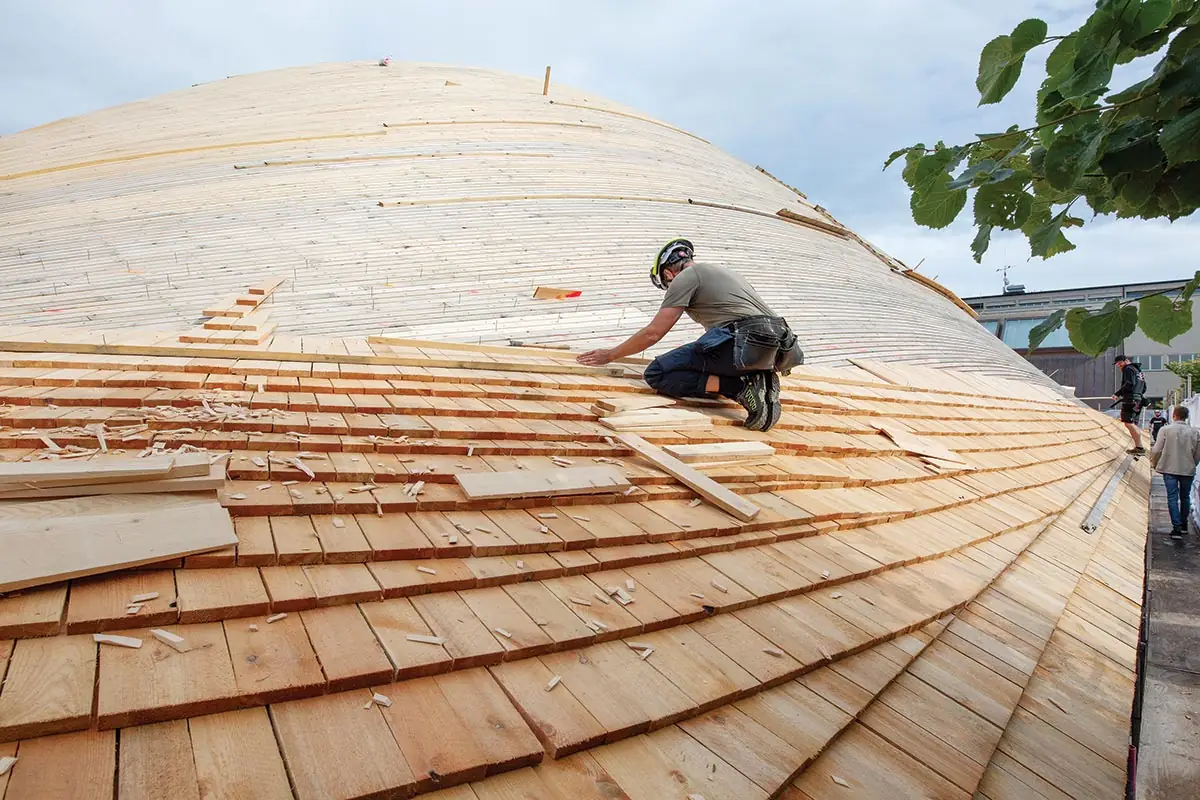
The roof is covered by 85,000 wood shingles. Photos © Anna Gerdén
Given the lateral thrust exerted by the vault, the columns that hold it up—massive agglomerations of LVL, 24 by 24 inches thick on the building’s shorter sides and 24 by 32 on the longer—were prestressed with bent steel rods inserted into their cores. To avoid fixing ductwork to the vault, air is brought in from under the floor and sucked out through the top of the dome theater. Milled in CLT, the latter includes two fully reclinable wheelchair stations among its 100 seats, an innovation pioneered at the museum. A large cooling apparatus for the six powerful projectors is located under the seating, while the screen, in microperforated aluminum, both absorbs sound and lets in air from ceiling-mounted ventilation ducts.
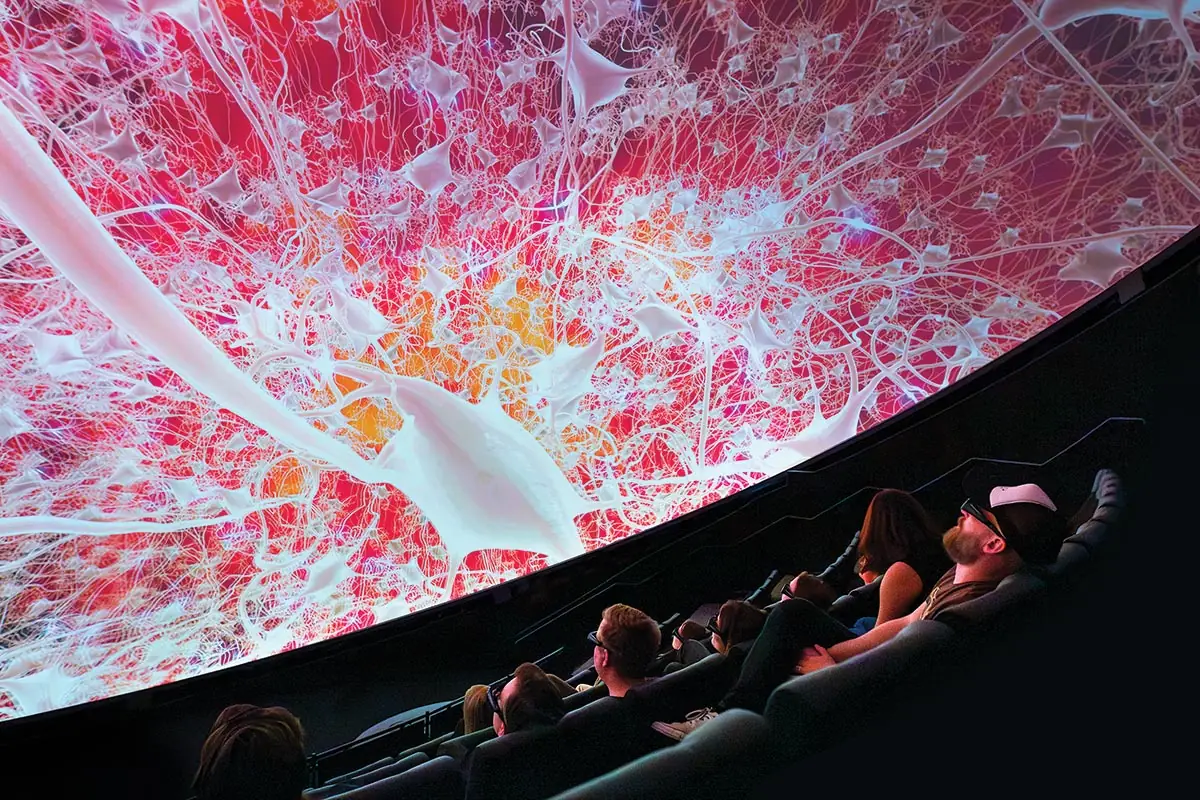
The dome theater offers immersive visuals. Photos © Anna Gerdén
At once modest and monumental, the events hall is a warm and welcoming space that houses a rectangular wooden block containing restrooms and a bar. Acoustically comfortable, even when crowded, it marks a welcome light-filled pause in an otherwise dense and windowless museum circuit, with its longer, south-facing facade giving onto an outdoor deck that is shaded in summer by ancient linden trees. Complete with a model and displays that explain its construction method and mechanical systems, the building forms an engaging exhibit in its own right. It remains to be seen whether the structure will spawn imitations elsewhere, but, for the museum and the architects, that was not the goal. Rather, they hope, it will start a conversation, and inspire others to take an equally inventive approach.
Click drawings to enlarge
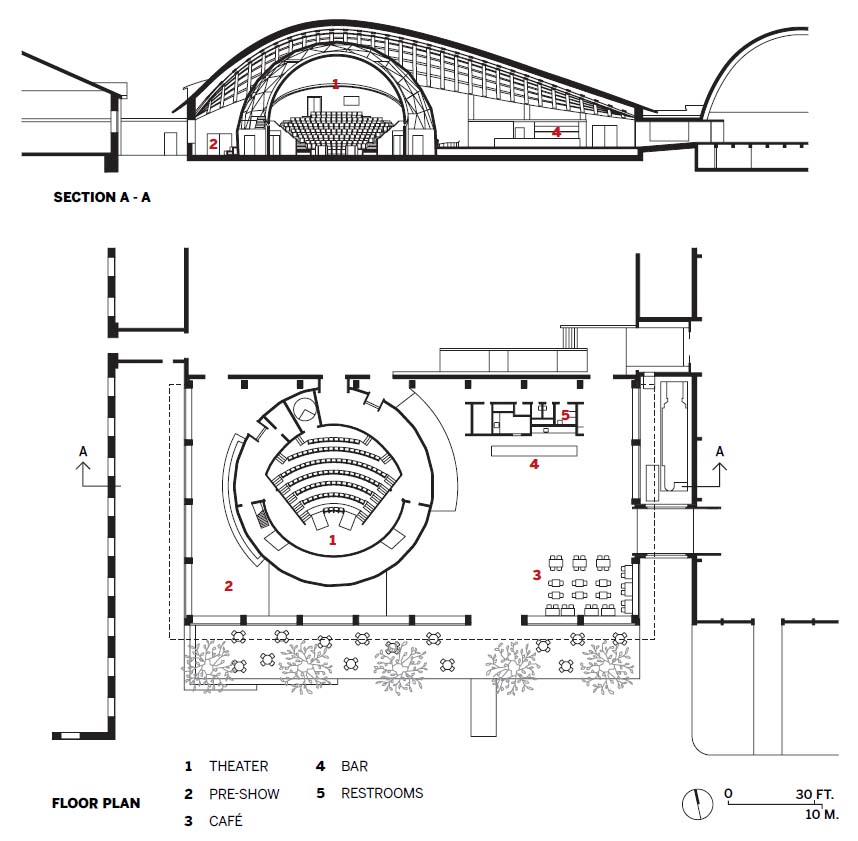
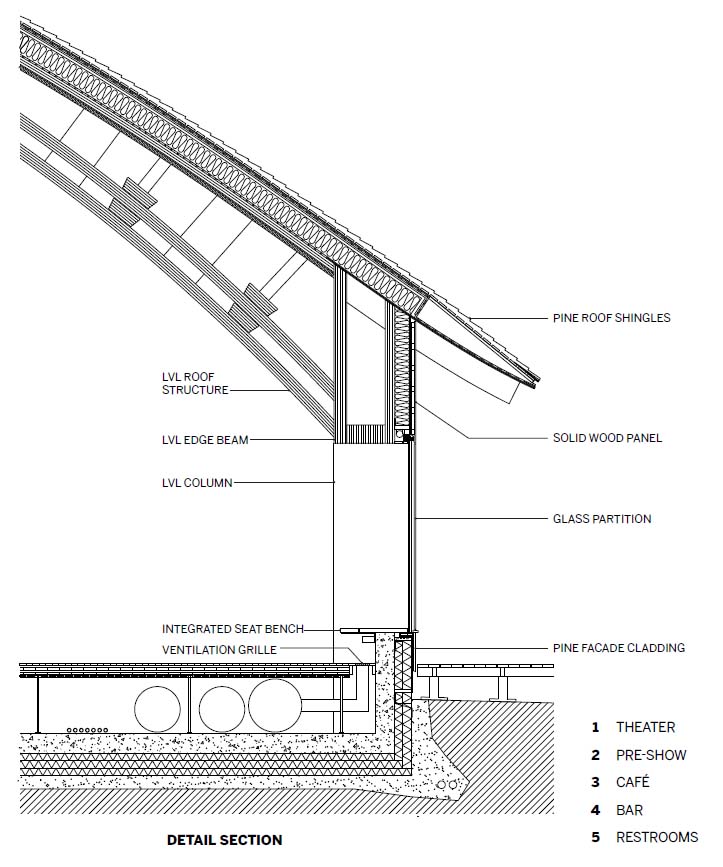
Credits
Architect:
Elding Oscarson
Engineers:
Florian Kosche DIFK (structural); SJB Kempter Fritze, Hermann Blumer (timber structure)
Consultant: Design to Production (parametric design)
General Contractor:
Oljibe, Blumer Lehmann (timber)
Client:
National Museum of Science and Technology
Size:
14,000 square feet
Cost:
$22 million
Completion Date:
December 2023
Sources
Exterior Wood Cladding:
Tilly
Glass:
Saint-Gobain
Roof Shingles:
Nykarleby
Doors:
Schüco Jansen (entrances); Daloc, Stålprofil (interior)
Acoustical Ceilings:
Akustikmiljö
Theater Seating:
Ilmonte, Kotobuki



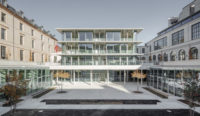

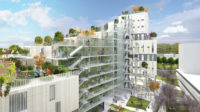
Post a comment to this article
Report Abusive Comment